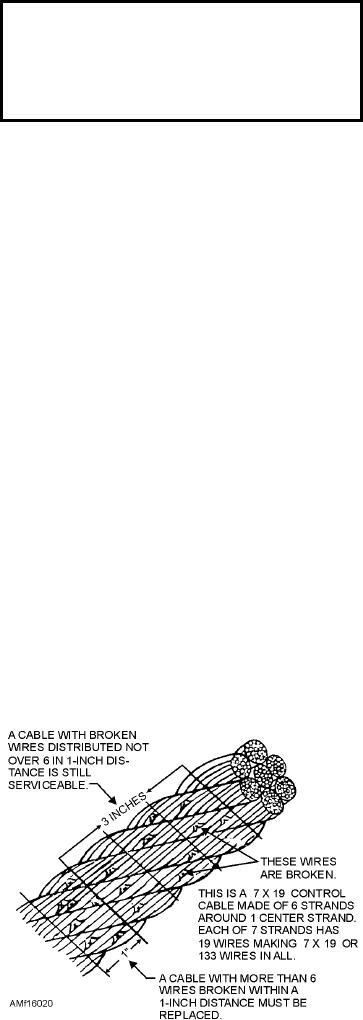
Cable and rigid control systems maintenance
WARNING
includes inspection to discover actual and potential
Your bare hands should NEVER be used to
defects, servicing with lubricants, and correction of
check for broken wires. Using your bare hands to
reported malfunctions and defects. Malfunctions that
check for broken wires could result in personal
occur in control systems include frayed and loosened
injury.
bearings, unnatural tightness (binding), and broken or
damaged components.
Tests have proven that control cables may have
CABLE CONTROL SYSTEM
broken wires and still be capable of carrying their
designated load. However, any 7 x 19 cable that shows
Cables have many advantages. They will not sever
more than six broken wires in any 1-inch length, or any
readily under sudden strains. Cables are stronger than
7 x 7 cable that shows more than three broken wires in
any 1-inch length, must be replaced. A maximum of
steel rods or tubing of the same size. They flex without
three broken wires per inch is allowable in the length of
setting (permanent deformation) and can be led easily
cables passing over pulleys, drums, or through
around obstacles by using pulleys. Cables can be
fairleads. Figure 16-20 shows how to determine if a
installed over long distances (such as in large aircraft)
cable is serviceable.
without a great degree of sagging or bending. Vibration
will not cause them to harden, crystallize, or break, as
Corrosion, kinking, and excessive wear should be
given particular attention during cable inspection. If a
may be the case with push-pull control rods. Because
cable is found to be kinked or badly worn, it should be
of the great number of wires used in cables, cable
replaced, even though the number of broken wires is
failure is never abrupt, but is progressive over periods
less than that specified for replacement. If the surface
of extended use. When used for the manipulation of a
of the cable is corroded, relieve the tension on the cable
unit in a control system, they are usually worked in
and carefully untwist it to visually inspect the interior.
pairs-one cable to move the unit in one direction, the
Any corrosion on the interior strands of the cable
other to move it in the opposite direction. Weight is
constitutes failure, and the cable must be replaced. If
saved in spite of a second cable because the push-pull
no internal corrosion is detected, remove loose,
rod needed to cause a similar movement in a unit would
external corrosion with a clean, dry rag or fiber brush
have to be quite thick and heavy (comparatively
and apply the specified preservative compound.
speaking). Since cables are used in pairs and are
NOTE: Do not use metal wool or solvents to clean
stretched taut, very little play is present in system
installed cable. Metal wool will embed tiny dissimilar
controls, and no lost motion exists between the
metal particles and create further corrosion problems.
a c t u a t i n g d ev i c e a n d t h e u n i t . C o n s e q u e n t l y,
The use of solvents will remove the internal cable
cable-controlled units respond quickly and accurately
lubricant and allow the cable strands to abrade and
to cockpit control movement. In some simple cable
further corrode.
systems, only one cable is used, and a spring provides
the return action.
Cable Maintenance
Cable control systems require more maintenance
than rigid linkage systems; therefore, they must be
inspected more thoroughly. Cables must be kept clean
and inspected periodically for broken wires, corrosion,
kinking, and excessive wear.
INSPECTION.--Broken wires are most apt to
occur in lengths of cable that pass over pulleys or
through fairleads. On certain periodic inspections,
cables are checked for broken wires by passing a cloth
along the length of the cable. Where the cloth snags the
cable is an indication of one or more broken wires.
Figure 16-20.--Determining serviceable cable.
16-24

